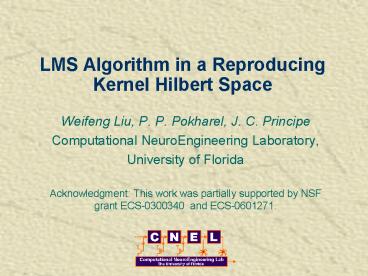LMS Algorithm in a Reproducing Kernel Hilbert Space - PowerPoint PPT Presentation
1 / 37
Title:
LMS Algorithm in a Reproducing Kernel Hilbert Space
Description:
LMS Algorithm in a Reproducing Kernel Hilbert Space Weifeng Liu, P. P. Pokharel, J. C. Principe Computational NeuroEngineering Laboratory, University of Florida – PowerPoint PPT presentation
Number of Views:112
Avg rating:3.0/5.0
Title: LMS Algorithm in a Reproducing Kernel Hilbert Space
1
LMS Algorithm in a Reproducing Kernel Hilbert
Space
- Weifeng Liu, P. P. Pokharel, J. C. Principe
- Computational NeuroEngineering Laboratory,
- University of Florida
- Acknowledgment This work was partially supported
by NSF grant ECS-0300340 and ECS-0601271.
2
Outlines
- Introduction
- Least Mean Square algorithm (easy)
- Reproducing kernel Hilbert space (tricky)
- The convergence and regularization analysis
(important) - Learning from error models (interesting)
3
Introduction
- Puskal (2006) Kernel LMS
- Kivinen, Smola (2004) Online learning with
kernels (more like leaky LMS) - Moody, Platt (1990s)Resource allocation
networks (growing and pruning)
4
LMS (1960, Widrow and Hoff)
- Given a sequence of examples from UR
- U a compact set of RL.
- The model is assumed
- The cost function
5
LMS
- The LMS algorithm
- The weight after n iteration
(1)
(2)
6
Reproducing kernel Hilbert space
- A continuous, symmetric, positive-definite kernel
,a mapping F, and an inner
product - H is the closure of the span of all F(u).
- Reproducing
- Kernel trick
- The induced norm
7
RKHS
- Kernel trick
- An inner product in the feature space
- A similarity measure you needed.
- Mercers theorem
8
Common kernels
- Gaussian kernel
- Polynomial kernel
9
Kernel LMS
- Transform the input ui to F(ui)
- Assume F(ui) ?RM
- The model is assumed
- The cost function
10
Kernel LMS
- The KLMS algorithm
- The weight after n iteration
(3)
(4)
11
Kernel LMS
(5)
12
Kernel LMS
- After the learning, the input-output relation
(6)
13
KLMS vs. RBF
- KLMS
- RBF
- a satisfy
- G is the gram matrix G(i,j)?(ui,uj)
- RBF needs regularization.
- Does KLMS need regularization?
(7)
(8)
14
KLMS vs. LMS
- Kernel LMS is nothing but LMS in the feature
space--a very high dimensional reproducing kernel
Hilbert space (MgtN) - Eigen-spread is awfuldoes it converge?
15
Example MG signal predication
- Time embedding 10.
- Learn rate 0.2
- 500 training data
- 100 test data point.
- Gaussian noise
- noise variance .04
16
Example MG signal predication
MSE Linear LMS KLMS RBF (?0) RBF (?.1) RBF (?1) RBF (?10)
training 0.021 0.0060 0 0.0026 0.0036 0.010
test 0.026 0.0066 0.019 0.0041 0.0050 0.014
17
Complexity Comparison
RBF KLMS LMS
Computation O(N3) O(N2) O(L)
Memory O(N2NL) O(NL) O(L)
18
The asymptotic analysis on convergencesmall
step-size theory
- Denote
- The correlation matrix
- is singular. Assume
- and
19
The asymptotic analysis on convergencesmall
step-size theory
- Denote
- we have
20
The weight stays at the initial place in the
0-eigen-value directions
- If
- we have
21
The 0-eigen-value directions does not affect the
MSE
- Denote
It does not care about the null space! It only
focuses on the data space!
22
The minimum norm initialization
- The initialization gives the
minimum norm possible solution.
23
Minimum norm solution
24
Learning is Ill-posed
25
Over-learning
26
Regularization Technique
- Learning from finite data is ill-posed.
- A priori information--Smoothness is needed.
- The norm of the function, which indicates the
slope of the linear operator is constrained. - In statistical learning theory, the norm is
associated with the confidence of uniform
convergence!
27
Regularized RBF
- The cost function
- or equivalently
28
KLMS as a learning algorithm
- The model with
- The following inequalities hold
- The proof(H8 robust triangle inequality
matrix transformation derivative )
29
The numerical analysis
- The solution of regularized RBF is
- The reason of ill-posedness is the inversion of
the matrix (G?I)
30
The numerical analysis
- The solution of KLMS is
- By the inequality we have
31
Example MG signal predication
weight KLMS RBF (?0) RBF (?.1) RBF (?1) RBF (?10)
norm 0.520 4.8e3 10.90 1.37 0.231
32
The conclusion
- The LMS algorithm can be readily used in a RKHS
to derive nonlinear algorithms. - From the machine learning view, the LMS method is
a simple tool to have a regularized solution.
33
Demo
34
Demo
35
LMS learning model
- An event happens, and a decision made.
- If the decision is correct, nothing happens.
- If an error is incurred, a correction is made on
the original model. - If we do things right, everything is fine and
life goes on. - If we do something wrong, lessons are drawn and
our abilities are honed.
36
Would we over-learn?
- If the real world is attempted to be modeled
mathematically, what dimension is appropriate? - Are we likely to over-learn?
- Are we using the LMS algorithm?
- What is good to remember the past?
- What is bad to be a perfectionist?
37
- "If you shut your door to all errors, truth will
be shut out."---Rabindranath Tagore































